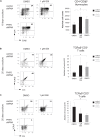PHF6 Expression Levels Impact Human Hematopoietic Stem Cell Differentiation
- PMID: 33251223
- PMCID: PMC7672048
- DOI: 10.3389/fcell.2020.599472
PHF6 Expression Levels Impact Human Hematopoietic Stem Cell Differentiation
Abstract
Transcriptional control of hematopoiesis involves complex regulatory networks and functional perturbations in one of these components often results in malignancies. Loss-of-function mutations in PHF6, encoding a presumed epigenetic regulator, have been primarily described in T cell acute lymphoblastic leukemia (T-ALL) and the first insights into its function in normal hematopoiesis only recently emerged from mouse modeling experiments. Here, we investigated the role of PHF6 in human blood cell development by performing knockdown studies in cord blood and thymus-derived hematopoietic precursors to evaluate the impact on lineage differentiation in well-established in vitro models. Our findings reveal that PHF6 levels differentially impact the differentiation of human hematopoietic progenitor cells into various blood cell lineages, with prominent effects on lymphoid and erythroid differentiation. We show that loss of PHF6 results in accelerated human T cell development through reduced expression of NOTCH1 and its downstream target genes. This functional interaction in developing thymocytes was confirmed in vivo using a phf6-deficient zebrafish model that also displayed accelerated developmental kinetics upon reduced phf6 or notch1 activation. In summary, our work reveals that appropriate control of PHF6 expression is important for normal human hematopoiesis and provides clues towards the role of PHF6 in T-ALL development.
Keywords: NOTCH; PHF6; T cell development; hematopoiesis; zebrafish.
Copyright © 2020 Loontiens, Dolens, Strubbe, Van de Walle, Moore, Depestel, Vanhauwaert, Matthijssens, Langenau, Speleman, Van Vlierberghe, Durinck and Taghon.
Figures







References
Grants and funding
LinkOut - more resources
Full Text Sources
Molecular Biology Databases

